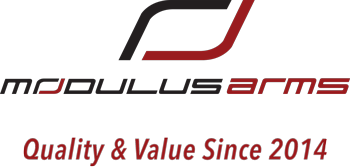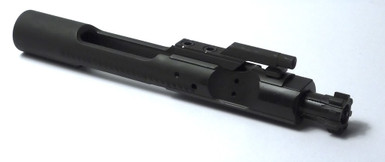Posted by Modulus Arms on 5th Oct 2021
Difference between an AR-15 and M16 BCG (Bolt Carrier Group)
The bolt carrier group (BCG) can be imagined as the mechanical heart of any AR style rifle. This light saber shaped component interacts directly with the rounds fired through your firearm; striking the primer, ejecting the spent casing, chambering a fresh round into the chamber. While browsing for this important part of your AR build, you’ll notice that bolt carrier groups have two different categories: AR-15 BCG's and M16 BCG's.
AR-15 vs M16 Bolt Carrier Group
Contrary to the narrative that “the assault rifle 15 is a dangerous weapon of war solely for the military”, the ArmaLite rifle 15 is the civilian variant that was designed for the civilian market in mind. Due to the National Firearms Act, for civilians to legally own full auto guns the firearm had to have been legally owned or manufactured prior to May 19, 1986. The key difference between the two types of BCG's actually come down to full auto capability.
The auto sear that allows the M16 to have full auto fire and three round burst fire has to be accommodated by an M16 lower parts kit. This sear also takes up that small U-shaped space in the lower receiver of an AR-15. A lower receiver for an M16 would have that space milled out for the auto sear as well as the fabled 'third hole' milled for the auto sear’s pin.
What is the difference between AR-15 BCG vs M16 BCG?
Now we know what the auto sear is and how it allows the M16 to have selective fire between full auto fire and burst fire. For the bolt carrier group of the M16 to function, it requires the extra material towards the back of the BCG that is otherwise not present on an AR-15 BCG. Simply put, AR-15 bolt carrier groups limit users to only be able to shoot in semi-automatic fire and M16 BCG's make it possible to shoot in full automatic fire.
The full auto lug makes the M16 BCG heavier than the AR-15 BCG and facilitates cycling during selective fire with the correct timing. The bolt carrier group of the AR-15 doesn't have the full auto lug and therefore is not capable of cycling full auto fire when installed. The full auto lug of the M16 BCG also provides a smoother cycling process on carbine length gas systems such as the M4 platform.
Will M16 BCG work in AR-15?
Yes, an M16 bolt carrier group is fully compatible with AR-15 lowers and AR-15 lower parts kits. However, it is not compatible the other way around. An AR-15 bolt carrier group cannot support the selective fire capability and is not able to support the M16 lower parts kit.
Is a M16 BCG legal?
Although full auto firearms are regulated by the NFA, the bolt carrier group itself does not fall under NFA regulations. Unlike the auto sear, you can freely purchase an M16 bolt carrier group as it's a non-FFL component. As it happens, M16 BCG's are actually most commonly sold now and strictly AR15 BCG's can be more difficult to find because it just make sense from a logistics perspective but also just practicality. Wouldn't you want the higher performing product for a similar or the same price?
Should I get an AR-15 BCG or an M16 BCG?
An M16 bolt carrier group is compatible with both the AR-15 and M16 while having the benefit of being more common to find (as the industry standard) & slightly smoother cycling. For general purposes, you won’t go wrong with an M16 BCG. However, the differences are really not that noticeable and the primary concern in choosing a bolt carrier group should be the bolt carrier group’s manufacturer.
Best BCG Brands
Toolcraft offers a variety of bolt carrier groups with top notch machining quality. In fact, most BCGs are made by Toolcraft and companies simply laser engrave their logos onto them after purchasing them to resell. Additionally, their BCGs come with a lifetime warranty in the event that you somehow manage to wear one out or break it. Their line of bolt carrier groups with DLC (Diamond-like Carbon) coating will make it difficult for the average shooter to make use of that warranty policy with only regular use. With self-lubricating ability, high corrosion-resistance and a coefficient of friction low enough to pass for drill bits, Toolcraft's DLC BCGs have thoroughly set the bar for BCG standards.
While Toolcraft is more commonly known for their OEM style BCGs, there are also other aftermarket parts companies known for making high end bolt carrier groups such as LMT. Karl Lewis, the owner and founder of Lewis Machine and Tool, was even endorsed by the original AR-15 designed Jim Sullivan. Possessing the durability to challenge even a Toyota Hilux, the LMT’s enhanced carrier is a top of the line BCG for overgassed AR rifles with carbine length gas tube systems. The proprietary alloy used by LMT’s enhanced bolt outclasses the industry standard of Carpenter 158 & 9310 Steel commonly used for bolts. The material and grooves cut into the locking lugs (to relieve stress) make a bolt that is built to last in a suppressed full auto system.
BCG Coating/Finishes
An important feature to consider on your bolt carrier group that can significantly impact performance is the coating. Here are the most common types of BCG coating and finishes to consider:
Shot Peening
Shot peening is a process that is done to supplement the finish of all mil-spec bolt carrier groups. If you've ever seen a shot peen hammer, you’ll have a bit of an idea of how this is already done on a macro scale. The “hammer” for this process is scaled down to a bombardment of tiny spherical pieces of ceramic/glass/metal that strikes the surface of the bolt carrier group at high speeds. Each piece makes a small indentation forming a surface of tiny layered craters that makes the surface resistant to cracks and stress.
Magnesium Phosphate/Chrome (Parkerized)
Standard mil-spec BCG finishes utilize a porous, parkerized surface unlike the shiny smooth surface of other coating options. This has the benefit of the protective phosphate absorbing lubricant for smoother cycling, however it is vulnerable to scratches and light marring. Despite the aesthetic issues, magnesium phosphate finish is the most cost effective on the market and has been put to use extensively by the US Armed Forces.
Black Nitride
A perfect balance between cost and quality of corrosion resistance, the popular black nitride finish is a thermochemical treatment of the BCG surface first through an SBN (Salt bath nitriding) in which molten salt solutions of nitrogen and carbon are bound to the material. The influx of nitrogen binds to the iron molecules to form a hardened and slick surface of iron nitride (Fe3N). Following the nitriding bath is the QPQ (quench polish quench) method of preventing corrosion. The BCG is placed into an oxygen rich salt solution and allowed to oxidize, forming magnetite (Fe3O4). This creates a corrosion resistant layer. After the first “quench”, the BCG undergoes another round of polishing to restore the finish which is followed by the last round of quenching. Users have to be wary that the coating will come off over prolonged use, but this is a finish that will get the job done with an easier time cleaning than phosphate finishes.
Physical Vapor Deposition
Lastly, we have one of the fastest growing finish technologies with unparalleled results — PVD (Physical Vapor Deposition) is a new process that is applied to critical sensitive devices from medical apparatuses to semiconductor wafers. The bolt carrier group is first placed in a vacuum chamber filled with an inert gas, such as argon or nitrogen, and given a negative charge. Argon is a monatomic gas and most commonly used for this application. An object with material that is desired to be coated onto the bolt carrier group will be placed inside the vacuum chamber with an electrical current running through the chamber.
Free floating electrons from the current will interact with argon gas by kicking off its outer electrons, making the argon gas molecules positively charged. Argon in its electron starved form will make a beeline for the electron rich source material object at an extremely high velocity, knocking and taking off molecules from the object. The molecules will settle and bind to the bolt carrier group’s surface inside the vacuum, forming a finish that is only several atoms thin and resistant to peeling, scratching, and chipping. This is a top of the line process that can deliver an incredible bolt carrier group in a variety of colors, however it does come with a steep cost as can be seen with Cryptic Coatings' premium line of bolt carrier groups.
Build your new AR-15 with Modulus Arms!
Have you put in an order for a new bolt carrier group already? Don't forget to check out our Router Jig Extreme and 80% lower receivers along with upper receiver parts to complete a new AR-15 build!

